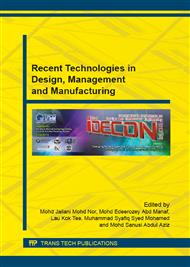p.52
p.59
p.63
p.68
p.73
p.79
p.83
p.88
p.93
Integration of Failure Mode Effect and Criticality Analysis (FMECA) and Analytical Hierarchy Process (AHP) to Improve the Packaging Process for Automotive Stamping Part
Abstract:
In the business world today, organizations must be able to respond promptly and efficiently to the changing market needs. Therefore, the flaw in the conventional approach such as inefficiency and time consumption can contribute to product failure in the marketplace. This hinders organizations to provide the performance required and should be improved to respond to the current situation. Concurrent engineering should be adopted to overcome the problems associated with the conventional approach. This paper focuses on minimizing the conventional method by implementing concurrent engineering tools and techniques. Thus, the main objective of this paper is to reduce the wastage of time and costs, as well as labor during packaging process, by identifying the failure of the existing process and choosing a new concept for the packaging process using the integration of FMECA and AHP approach. Failures in the current procedure of packaging process were identified by using FMECA analysis, and 4 new concepts were proposed to improve the packaging process. To select the best concept, AHP was used due to the variety aspects to be considered, such as performance, maintenance, time of development, cost of development and potential cause of failure, in the selection of new concepts. The result shows that the proposed new concept for the packaging process can reduce the time, costs, and labor, in addition to the various aspects considered in the selection of a new concept. This paper presents the importance of considering the concurrent engineering tools in the manufacturing industry.
Info:
Periodical:
Pages:
73-78
Citation:
Online since:
May 2015
Authors:
Price:
Сopyright:
© 2015 Trans Tech Publications Ltd. All Rights Reserved
Share:
Citation:


